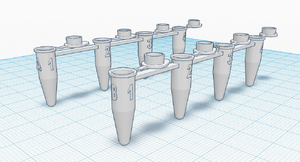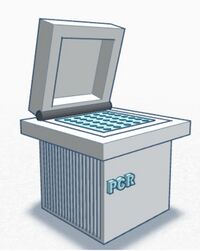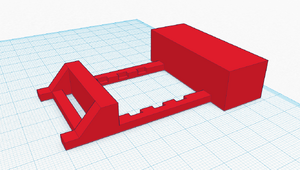BME100 f2013:W1200 Group4 L6
| Home People Lab Write-Up 1 | Lab Write-Up 2 | Lab Write-Up 3 Lab Write-Up 4 | Lab Write-Up 5 | Lab Write-Up 6 Course Logistics For Instructors Photos Wiki Editing Help | ||||||
OUR COMPANY
Company: Everyday DNA
LAB 6 WRITE-UPComputer-Aided DesignTinkerCAD TinkerCAD is a web based tool that allows users to design printable 3D objects. These printable 3D objects are created by various shapes found in the directory towards the right side of the page. The software allows for the manipulation of the three dimensional shapes to exact measurements, providing the user with accurate scale modeling capability. TinkerCAD also allows user to have their 3D objects viewable to the public, allowing anyone who wants to improve the object or 'tinker" to do so. This public feature also allows users to use certain objects as the basic design for their 3D objects. TInkerCAD was used by the product designers for EverydayDNA in the lab on November 20th to improve the designs of the flourimeter and PCR test tube used in previous labs.  Implications of Using TinkerCAD for Design TinkerCAD allows the the engineer to crate visual prototypes and designs in a virtual space, allowing them to know how the design will look before it is built. This capability allows the engineer to more accurately manipulate the prototypes parts and will help to improve on the design as a whole. TinkerCAD can also be very useful when it comes to redesigning an item. For example, our company, EverydayDNA, redesigned the PCR tubes. TinkerCAD allows you to easily make different changes and see how they look in 3D. The product designers for EverydayDNA decided to connect the PCR tubes into two strips of four. This allows the user to handle the tubes better and keep them all together. A small hook in the middle of each strip was also added in order to make it easier to pick up and navigate the PCR tubes. Lastly, EverydayDNA's kit features tubes that are already labeled. When PCR testing was done previously, there was a risk of the labels made in marker coming off. This would have created a problem of not knowing which tube was which. The changes made fix this problem. TinkerCAD allowed the design to be changed in different ways before making the final decision. It also allowed the design to be viewed prior to manufacturing, which helped determine if it would be a beneficial change to make. Feature 1: Cancer SNP-Specific PrimersBackground on the cancer-associated mutation The polymerase chain reaction (PCR) technique can be applied to detect a cancer-associated DNA sequence, or SNP. SNP stands for "single nucleotide polymorphism". A nucleotide is where monomers of nucleic acids, such as DNA and RNA, transfer ATP, and polymorphisms occur when two or more phenotypes are expressed in the same species. The cancer-associated SNP rs17879961 is found in all homosapiens (humans), and is pathogenic, meaning that it is able to cause disease. It is harmful to the system when this specific strand of RNA is expressed. It occurs on chromosome number 22, out of the 23 total pairs most people have. When the mutation occurs, it affects the strand that codes for checkpoint kinase 2 (CHEK2). CHEK2 is the stabilizer for the tumor suppressor p53. When the rs17879961 SNP mutation affects the gene strand for CHEK2, p53 is no longer stabilized and tumor suppression does not occur. This situation can lead to several different types of cancer, making the rs17879961 SNP a concern. Primer design
Primers are designed specifically to match the segment of DNA that it being copied. During the PCR process, one primer attaches to the top strand at one end of the segment of interest, and the other primer attaches to the bottom strand at the other end. The primers signal the DNA polymerase to add the complementary nucleotides to the DNA, resulting in a copy of the DNA strand the primers singled out. This copying continues until the PCR process is complete. Only the DNA containing rs17879961 is copied because the the DNA polymerase will only copy segments attached to primers, and primers will only attach to the targeted segments, not the non-cancer alleles. Feature 2: Consumables KitEverydayDNA's consumables kit will include a stackable tip system that provides a stable stand for the pipette tips. This will hold all the tips in place and prevent them from tipping over when picking up new tips. The new test tubes will be connected into groups of four for convenience and will each contain a small handle to prevent spillage when handling the tubes. The kit will also include a few opaque colored tubes for the SYBR Green as opposed to translucent tubes. This will prevent the SYBR Green from being exposed to flourescent light, which can bleach it and render it ineffective. Another change that can be made to the test tubes is the addition of a label holder. This will be added in order to ensure that the marker used to write the label does not rub off while handling the test tubes. Feature 3: PCR Machine Hardware The PCR machine is included in EverydayDNA's system as a method of amplifying the DNA molecules by continuously raising and lowering the temperature of the DNA. This amplification will enable the DNA molecules to be easily analyzed. The major weaknesses of the PCR machines from previous testing were their slow speed and bulky size. In order to make a more compact PCR machine, the dimensions of the PCR were altered from 20 x 13 x 25cm to 15 x 10 x 20 cm. The speed was addressed by changing the temperature blocks to an easily heated alloy. The alloys max block ramp rate and max sample rate are respectively 4.15[math]\displaystyle{ ^O }[/math]C/sec and 3.95[math]\displaystyle{ ^O }[/math]C/sec. The new temperature blocks can hold 35 PCR tubes, while the old PCR could only handle 16. Feature 4: Fluorimeter HardwareThe fluorimeter portion of EverydayDNA's kit consists of a blue LED-light fluorimeter with a phone stand attachment and glass slides for analysis. The glass slides come in in a box of twenty, with several extras in case of contamination. One of the biggest issues with the fluorimeter of previous systems was that it was very difficult to regulate the distance between the camera and the fluorimeter and maintain a proper camera angle. To combat this, the EverydayDNA's new diagnostic system contains a fluorimeter with a connected phone stand, as seen in the picture. The phone stand can be placed in any of the four notches on the horizontal pieces coming off the fluorimeter. This allows the distance to be adjusted while still allowing it to be regulated, making it difficult to accidentally alter the distance from the camera to the fluorimeter, which could negatively affect the data.  Bonus Opportunity: What Bayesian Stats Imply About The BME100 Diagnostic ApproachThe result from calculation 3 is very small, almost around one tenth of one, and implies that the CHEK2 PCR is not accurate a predicting that a patient possessing the SNP(single-nucleotide polymorphism) CHEK2 will test positive for cancer. The not very big result from calculation 4 implies the CHEK2 PCR is somewhat reliable at predicting that a patient possessing the SNP CHEK2 would test negative for cancer. |
||||||




